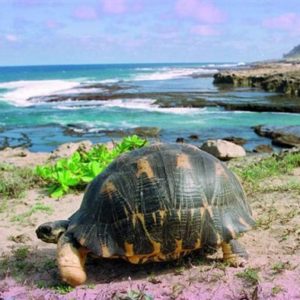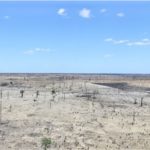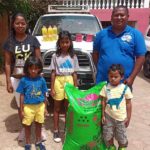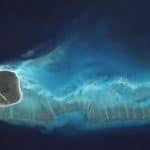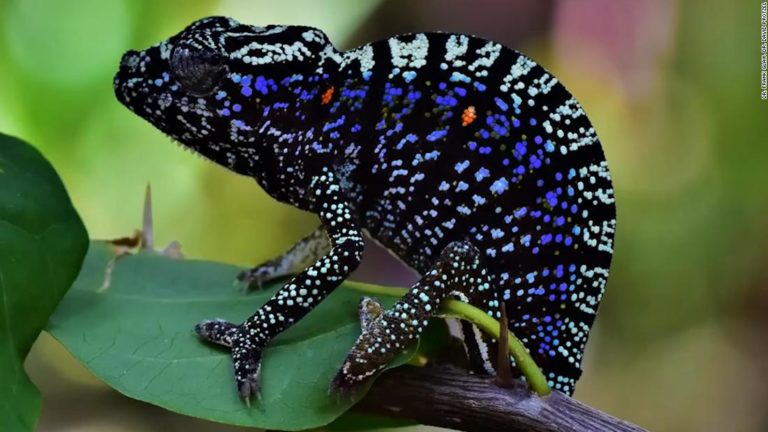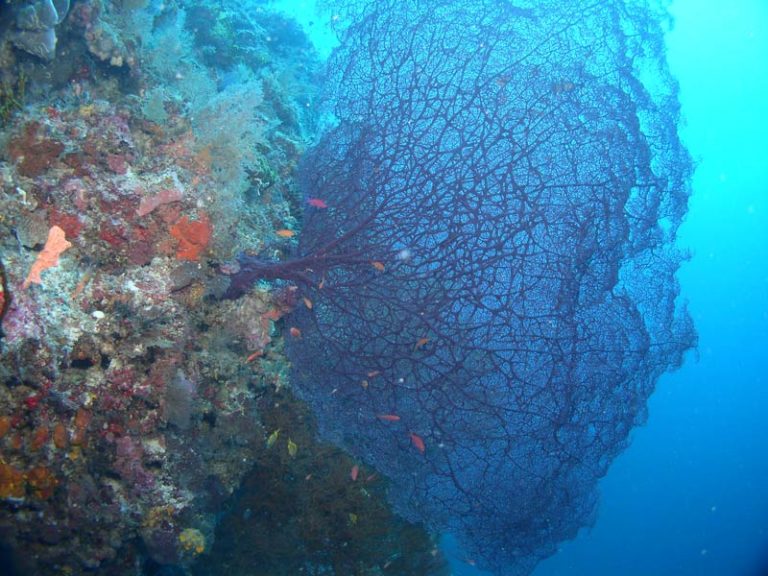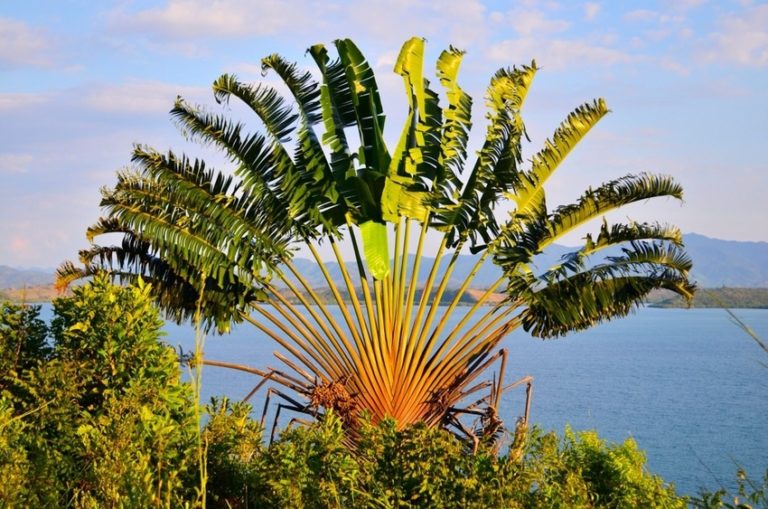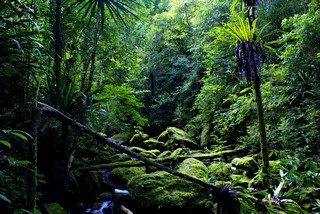The turtles from Madagascar
Land turtles- Freshwater turtles - Sea turtles
The world's oldest reptiles are well represented on the island, but a large proportion of these animals, long hunted for their meat, are threatened with extinction.
The Malagasy turtles-General description
The Madagascar turtles are among the most prized turtles in the world. The 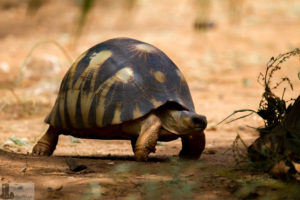
Some species like Erymnochelys Madagascariensis also have exceptional medicinal properties, which is one of the reasons for the illegal export and decline of these species.
The land and freshwater turtles of Madagascar are well known, especially for their star-shaped shells.
In addition, they are very often the subject of illegal trade of all kinds.
News about seizures of Malagasy turtles are easy to find on the Internet, all over the world and especially in neighboring islands and Southeast Asia.
It should be noted that today turtles are endangered in Madagascar, are banned for export and are specially monitored.
The Malagasy themselves are not allowed to take turtles home after their vacation, ray turtles have always been a popular pet.
The turtles of Madagascar belong to three families, the Family Testudinidae, the Family Pelomedusidae and the Family Podocnemidae.
Insges
In Madagascar, you cannot talk about turtles without Nosy Iranja or Turtle Island to mention. This magnificent island of about 200 hectares in the northwest of Madagascar is famous mainly thanks to these reptiles that are abundant in this corner.
It is also a privileged place for tourists to meet this animal.
The Genus Astrochelys includes two species, all endemic to Madagascar but introduced to the neighboring islands of Mauritius and Réunion.
The Madagascar tortoises
Astrochelys radiata
The Madagascar star tortoise or Astrochelys radiata is one of the best known tortoise species in Madagascar.

However, it is an endangered species, threatened by the destruction of its natural habitat and by poaching. It is a protected species listed in Appendix I (Most Endangered Species) of the Washington Convention on International Trade in Endangered Species.
Identification
The Astrochelys Radiata is most recognizable by its very curved shell with stripes in the shape of stars or sunbeams. It consists of five vertebral plates, four ribbed plates on both sides of the flanks and marginal plates that form the carapace.
Its head is bicolor, blackish brown above and yellow and light below.
It is a very gentle animal that likes to be scratched on the head at the first opportunity.
Features
It is an animal that is particularly active during the day in the heat and hides under the bushes at night. The Astrochelys Radiata also likes rainy weather and muddy soils.

The star tortoise lives in the southwest of Madagascar, on a coastal area of 200 km between Amboasary and Morombe.
Conservations
The Astrochelys radiata is protected under Malagasy law (Decree 60126 of October 1960).
Export and even transport on Malagasy territory is classified as prohibited. It is also present in several reserves and national parks of this region.
There are also sanctuaries for the reintroduction of confiscated animals in Ifaty which can also be visited.
Astrochelys Yniphora
The Ploughshare tortoise or Astrochelys yniphora is a turtle that lives near the Soalala city lives.
The AngonokaThe Malagasy ploughshare tortoise or Astrochelys Yniphora is a land tortoise that can be found especially in the reserve of the Bay of Baly and around the city of Soalala can encounter.
It is a species classified as "critically endangered", threatened by the destruction of its natural habitat, mainly by bushfires, but also by poaching.
It is a protected species listed in Appendix I (Most Endangered Species) of the Washington Convention on International Trade in Endangered Species.
Identification
The Astrochelys Yniphora has a very imposing carapace. It can measure up to about 50 cm, with a weight of up to 12 kg.
It is one of the largest turtles living on the island, the color of the shell is different in adults and juveniles.
The young have a relatively pale carapace and skin. The rib and vertebral scales are surrounded by black stripes, which disappear with age.
The head is bicolored, dark brown and beige on the underside.
Features
It is an animal that is quite active very early in the day and hides during the hottest part of the afternoon, then comes out at sunset.
The Angonoka feeds mainly on dried plants, seeds and bamboo.
Locations
The Ploughshare tortoise is only possible on small territories near the Bay of Baly to see.
There are exactly 5 small territories: Sada and Behata, Ambatomainty, Betainalika and Andrafiafaly. It lives in areas with scrub, bamboo and shrubs....
Conservations
The Astrochelys Yniphora is under the protection of the Malagasy law (Decree 60126 of October 1960). The export and even the transport on Malagasy territory is classified as prohibited.
National Park: Bay of Baly
Natural enemies of the ploughshare tortoise
The largest predators of the Angonoka are the Fossa and the Wild boar Potamochoerus larvatus.
The genus Pyxis (spider tortoises)
The genus Pyxis is also endemic to Madagascar and includes two species.
Pyxis arachnoides
The Arachnoid pyxis or pyxis arachnoides is one of the most famous turtles of Madagascar. It has three subspecies: Pyxis arachnoides arachnoides, Pyxis arachnoides brygooi and Pyxis arachnoides oblonga..

It is a species classified as critically endangered.
The Spider pyxids are threatened by the destruction of their natural habitat and then by poaching.
It is, in fact, a very prized animal that is the subject of many smuggling operations. In addition, it also consumes the local population.
Identification
It is believed that the arachnoid pyxis, a relatively small animal (about 15 cm), can live more than 70 years, although this theory has not yet been truly verified.

The three subspecies can also be distinguished by their plastron. That of the Brygooi is rigid, that of the Arachnoid is medium in size, and that of the Oblonga is well movable.
The male can be recognized by a longer and thicker tail.
Features
The Arachnoid Pyxis lives in dry and rocky forests, where you can expect temperature up to 40°C.
However, pyxids come out only in humid weather or less merciful heat and burrow under shrubs, under tree roots, and under humus when it is too hot.
This is a trait that keeps pyxids in captivity; they will hide under your bed or furniture if the heat is too high.

Pyxids feed on insects, dried leaves and dead fruits and they can get by on very little food. In fact, they do not really expend much energy, but they can sometimes be very active, despite the shells on their backs.
Locations
The Arachnoid pyxis lives in the south and southwest of Madagascar, on a territory of 100 km along the coast.
From Tuléar to Morombe one encounters mainly the Brygooi arachnoid pyxis. From Morombe to Anakao it is the habitat of the Pyxis arachnoides. And everywhere in the south, from Anakao to Andohahela, we find especially the Oblonga Pyxis arachnoides.
Conservations
Pyxis arachnoides is under the protection of the Malagasy law (Decree 60126 of October 1960). The export and even the transport on Malagasy territory is classified as prohibited. It is the subject of a special protection within the Parks Tsimanampetsotsa, Andohahela and Cape Sainte-Marie.
NP: Tsimanampetsotsa, Andohahela.
RS: Cape Sainte-Marie.
Pyxis planicauda
The Kapidolo, flat-back pyxis, flat-tailed pyxis, or pyxis planicauda. is a turtle of the genus Pyxis or spider web turtles.

There is a spider web pattern on its carapace.
It is a species classified as critically endangered, the Kapidolo are threatened by the destruction of their natural habitat and poaching.
Identification
The Pyxis planicauda is easily recognized by its flattened carapace, which is flatter than that of most turtles and especially that of its neighbor Pyxis arachnoides, with a yellowish pattern that gives the impression of a spider web.
Features
Pyxis planicauda lives in dry and rocky forests.
But it is the nature of Pyxis turtles that they only come out when the heat is not so mild or when the weather is humid. In the meantime, they hide under bushes and under the ground.
Pyxis planicauda feeds on insects, dried leaves and dead fruits and can be satisfied with very little.
Locations
Pyxis planicauda is located in a very small coastal area of the Menabe region, south of the River Tsiribihina, near the Special reserve of Andranomena.
Conservations
The Pyxis Planicauda is under the protection of the Malagasy law (Decree 60126 of October 1960). The export and even the transport on Malagasy territory is classified as prohibited.
It is under special protection within the Andranomena special reserve.
RS: Andranomena.
Madagascar freshwater turtles
The genus Pelomedusa
The genus Pelomedusa has only one species, the Pelomedusa subrufa.
The African Pelomedusa subrufa is an Water turtlewhich are also used throughout the African 
In fact, the Species Pelomedusa Subrufa three subspecies, but only the Pelomedusa Subrufa Subrufa is found in Madagascar.
The other two subspecies are Pelomedusa Subrufa Olivacea and Pelomedusa Subrufa Nigra.
However, the animal was discovered in 1788 in Madagascar under the name of Testudo planitia discovered and described for the first time.
Identification
The African Pelomedusa subrufa has a flattened carapace that ranges in color from dark olive green to dark brown to black. It has a grayish skin.
The adult animal measures about 20 cm. Its legs have claws and are not webbed.
Features
It is an exclusively carnivorous animal, it feeds on insects, mollusks, crustaceans, worms, fish and small mammals.
Locations
The Helmeted tortoise Pelomedusa Subrufa occurs mainly in the western part of Madagascar, in the northernmost Boeny region and in the southernmost Androy region before.
Conservations
In Madagascar, this animal is not subject to conservation measures. However, it is present in some national parks and reserves like Namoroka, Baly Bay, Ankarafantsika, Kirindy Mitea, Tsimanampetsotsa or Andohahela to find.
Pelusios Subniger
Pelusios Subniger is a semi-aquatic species of turtle that lives in the eastern part of Madagascar, near Tamatave, can be found.

It is a turtle that also exists in the eastern part of Africa.
In fact, the species Pelusios Subniger has two subspecies, but only the Pelusios Subniger Subniger exists in Madagascar, as incidentally on the African continent.
In fact, the species Pelusios Subniger Parietalis is endemic to the Seychelles archipelago.
Identification
As the name suggests, the blackish pelus has a carapace and skin that becomes black or dark brown. The adult is not larger than 20 cm.
Features
Pelusios subniger feeds on fish, snails, frogs, crabs, aquatic plants and fruits.
It is an animal that is most active at night and basks in the sun during the day.
Locations
Pelusios subniger occurs mainly in the eastern part of Madagascar, throughout the forest corridor and in the coastal zone, especially at low altitudes.
It is found near lakes, rivers, swamps and ponds, which are very abundant in this part of the island.
Pelusios castanoides
The Pelusios castanoides is a semi-aquatic turtle found in northwestern Madagascar.
The Yellow-bellied Pelusoid or Pelusios Castanoides is a semi-aquatic turtle from the Pelomeducidae family, which lives in the northwestern part of Madagascar.
It is a species that Madagascar shares with the African continent.
It is also one of the most famous species of semi-aquatic turtles in the world.
In fact, the species Pelusios Castanoides has two subspecies, but only the species Pelusios Castanoides exists in Madagascar, as well as on the African continent.
The other subspecies, Pelusios Castanoides Intergularis, is endemic to the Seychelles archipelago.
Identification
The yellow-bellied turtle has a dark brown carapace on the upper side and a slightly yellowish-yellowish carapace on the underside. The adults are not larger than 20 cm.
Locations
The Pelusios castanoides is a semi-aquatic animal.
It is found mainly near bodies of water, especially rivers and streams, which are abundant in the northwestern part of Madagascar.
The genus Erymnochelys
The Madagascar large-headed tortoise or Erymnochelys Madagascariensis is the only representative of the genus Erymnochelys and endemic to Madagascar.

However, it is subject to legal and controlled export to Asia. In fact, it is also known in Chinese medicine for its medicinal properties.
The Turtle Conservation Fund (TCF) currently provides $5.6 million for conservation and education activities to conserve Erymnochelys Madagascariensis.
Identification
The Big-headed turtle can be recognized by their very dark carapace and large head.
The Erymnochelys Madagascariensis can measure up to 50 cm. It is also very large, a feature that strongly distinguishes him from other species.
The same is true for its head, which is abnormally larger than in other species.
Features
The Erymnochelys Madagascariensis is an aquatic turtle.
It is quite rare to find on sandy shores, for example, it prefers rocks and rugged terrain. 
Locations
The Erymnochelys Madagascariensis lives throughout the western part of Madagascar, never far from bodies of water such as rivers or lakes.
Conservations
The Erymnochelys Madagascariensis is under the protection of Malagasy law. The export is highly regulated.
RS: Bemaraha
NP: Ankarafantsika, Bay of Baly, Bemaraha
Sea turtles from Madagascar
Madagascar, due to its geographical location in the Indian Ocean also the passage point for several sea turtles and sometimes migratory turtles.
We can name five of them:
The Caretta caretta
The turtle known as Caouanne is a sea turtle weighing up to 200 kg for 112 cm in the largest specimens.

Their jaws are thick, their reddish-brown color and their two claws on each fin allow us to easily distinguish them from other sea turtle species.
Also, unlike other species such as the hawksbill turtle, the scales do not overlap and the first rib scale is in contact with the nucleus.
Distribution and habitat
There are two subspecies:
Caretta caretta gigas found in the Pacific and Indian Oceans.
Caretta caretta found in the Atlantic Ocean.
Sea turtles of the species Caretta caretta enjoy temperate waters and migrate according to the season. This turtle lives near coasts, reefs and brackish water lagoons.
Caretta caretta lifestyle
Initially, the young turtles are omnivorous and feed mainly on sponges, jellyfish, crustaceans, fish eggs and algae from the Sargasso Sea.

Spawning occurs between May and October approximately every two to three years.
Each female lays about 120 eggs per nest 4 to 6 times per season, with a two-week interval between each laying.
The diameter of the eggs is between 3.5 cm and 5 cm. The incubation period is about two months.
The sex of the young is determined by the incubation temperature. The higher the temperatures, the more females the young will be.
The green turtle or Chelonya midas
It is called "green turtle", not because of its color (which is not green), but because of the color of its fat, which is green. It is the second largest species of sea turtle.

Species description
Breastplate of turtles-It is difficult to describe the color of individuals of this species for the simple reason that the color varies with age, and after adulthood there are still variations in hue.
At the exit of the egg the baby has a black acut and the plastron is white. Between the ages of about two and fifteen years, the color of the shell changes and becomes brown on the back and beige on the breastplate.
From the age of 15 years their color changes again to a much darker color, ranging from dark brown to a very dark olive-green color, sometimes even grayish. The head is relatively small and has one pair of prefrontal and four postocular scales.
The upper side is convex and oval in shape. It has four costal scales, four (sometimes five) vertebral scales, one pygal scale, and one divided supracaudal scale. The scales are "joined", i.e., glued together, unlike the hawksbill turtle, whose scales overlap like the tiles on a roof.
Males differ from females in the size of the tail, which is longer and thicker in males because the penis is inside, and in the presence of a claw on the anterior pectoral fins of males that allows them to grip the back of females during mating.
The green turtle, unlike tortoises, has no vocal cords.
The hawksbill turtle, Eretmochelys imbricata
It is a turtle that you may have heard of before and that Hawksbill turtle is called. It is one of the eight species of sea turtles that exist today and the only one of the genus Eretmochelys.
Its range is almost global, as it is found in all oceans. It has two subspecies: E.imbricata imbricata and E.imbricata bissa.
The hawksbill turtle was originally named in 1766 by Carl von Linné as the Testudo imbricata described.
In the early 19th century, systematics were refined and sea turtles were recognized as sharing common characteristics and grouped into common taxa.
A new genus Eretmochelys (from Greek: eretmo, oar and Chelys, turtle) was proposed in 1843 by the Austrian zoologist Leopold Fitzinger.
Description of Eretmochelys imbricata
Its shell is very easy to distinguish from other species. It is called hawksbill turtle because its scales overlap so that they look like the tiles on the roof of a house.
Only in some old specimens this feature is no longer valid, as the top tends to become smooth with time.
There are four pairs of ribs and five vertebral scutes, which may have a slight carina in young specimens. Another characteristic of this turtle is that it has posterior serrated margins.
The tank of the Eretmochelys imbricata is orange-brown to black in color, this coloration is an unre
The plastron is yellow, the post-anal scales are the same color with black spots. The fins are brown on the upper side and yellow on the underside.
On the head it has four prefrontal scales and a particularly long hooked beak.
Eretmochelys imbricata Males are characterized by lighter pigmentation and, as in other turtle species, a concave plastron, longer claws, and a thicker tail.
As for its size, it is between 60 cm and 1 m20 long and weighs between 60 kg and 90 kg.
The Lepidochelys olivacea
The Lepidochelys olivacea, one of the world's most widespread sea turtles. Lepidochelys olivacea, the olive ridley turtle is a species of turtle in the family Cheloniidae. It owes its name to the olive green color of its shell....
The leatherback turtle (Dermochelys coriacea)
Dermochelys coriacea, the largest of the turtles.

Description of leatherback turtle
It is the largest chelonian in the world, as this species can reach a weight of one ton at a length of 3 meters.
It has the peculiarity that it does not have a bony shell like other sea turtles. Its shell consists of a fine skin covering a thick layer of fat and numerous tiny osteoderms that give it the appearance of leather.
One notes the presence of 7 stripes that cover the back longitudinally. It has enormous flat and profiled front fins up to 2 m long, which allow it to swim extremely fast.
The Leatherback turtle is the most hydrodynamic sea turtle due to their shape and their 
Its skin is generally dark blue with many lighter spots or sometimes its body is completely gray or dark.
Distribution and habitat of this large sea turtle
The leatherback turtle prefers to live in the oceans, although some specimens currently live in the Mediterranean Sea, for example. There are three large populations distributed around the globe (Indian Ocean, Atlantic Ocean and Pacific Ocean) in tropical and subtropical areas. It is the only sea turtle that can venture into the cold waters of the north and south of the world. Dives to depths greater than 1300 m are recorded.
Way of life of Dermochelys coriacea
It is a turtle that migrates according to the populations of jellyfish and other animals that make up the bulk of its diet. It does not disdain the consumption of crustaceans, fish, carrion and sometimes even algae.
The presence of plastic bags in the seas and oceans leads to an increase in mortality. In fact, the turtles mistake the plastic bags for jellyfish and this has the effect of hindering the digestive voices.
Its way of life is not well known, except that they travel very long distances and that they spend their days in deep water and the nights more on the surface, however, on average they have to ascend every hour to breathe.
The females lay their eggs in places attached to them (always the same). The average number of eggs laid is 2 to 3, but up to 5 may be laid at intervals of 10 to 15 days. Each clutch consists of 100 to 200 eggs, 5 cm in diameter and weighing 40 to 50 grams each.
Incubation lasts 60-70 days and the newborns come out of the nest. They are 7 cm long and their goal is to reach the water.
The path between the nest and the sea is full of obstacles due to the presence of many predators (birds, crabs, dogs and other mammals, as well as large fish waiting).
Poaching remains a problem for all turtle species present in Madagascar.

